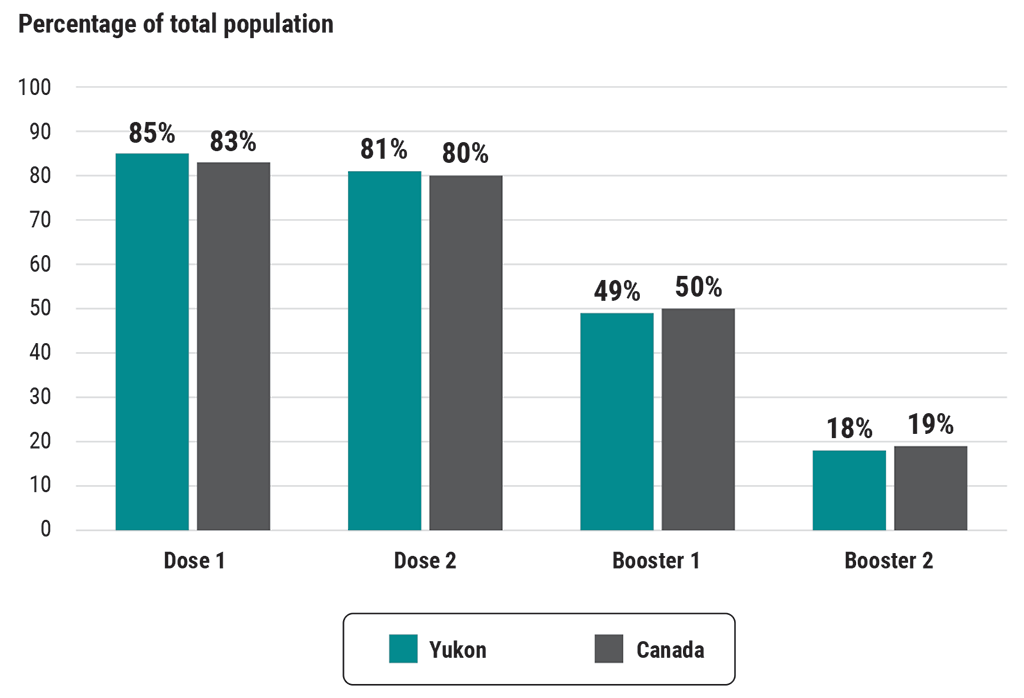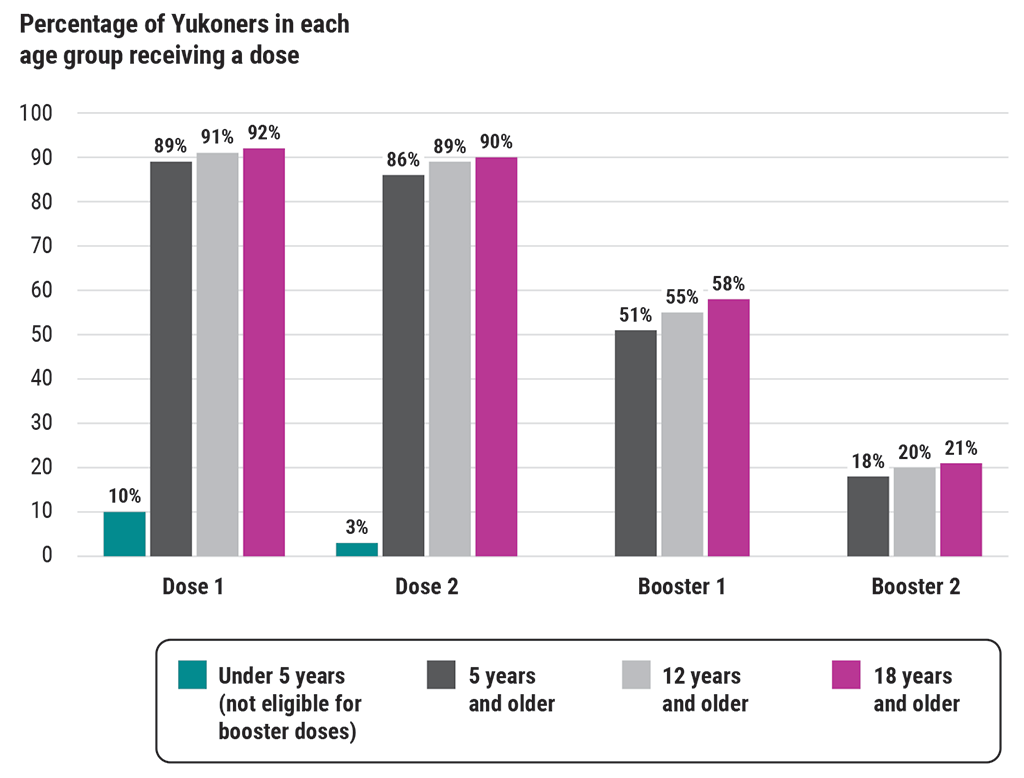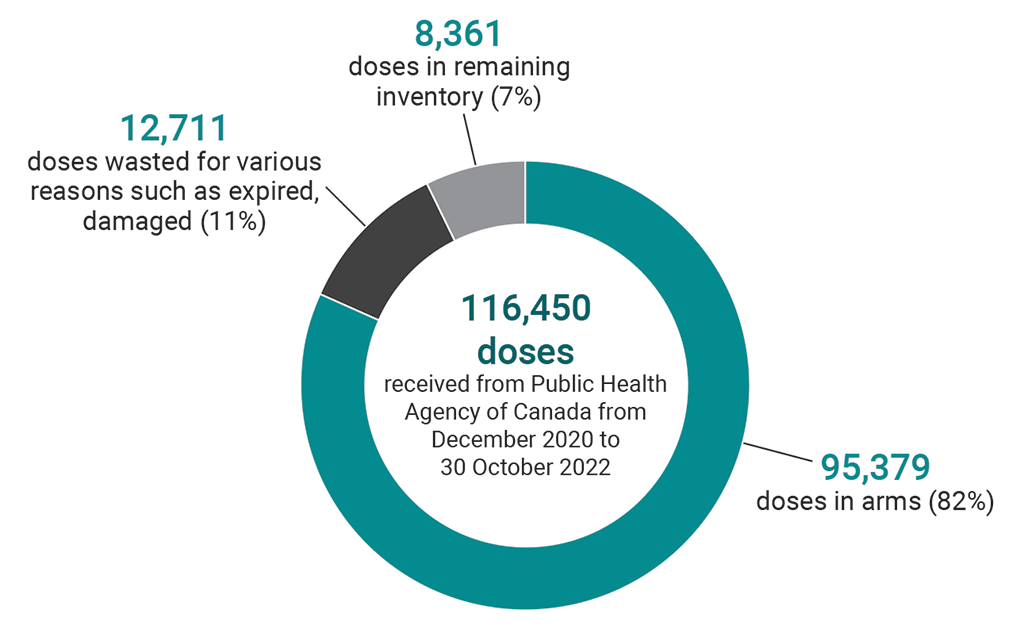2023 Report of the Auditor General of Canada to the Yukon Legislative Assembly
COVID-19 Vaccines in Yukon
At a Glance
Overall, the 3 departments responsible for the rollout of COVID‑19 vaccines in Yukon worked well together to overcome hurdles and vaccinate residents quickly. Within 6 weeks of receiving the first shipment of vaccines, the departments vaccinated priority vulnerable groups in Whitehorse, such as seniors and high-risk health-care workers. In parallel, mobile teams travelled to rural communities, making vaccines accessible to everyone aged 18 and older. This allowed the residents of Yukon to be vaccinated in their community or within close proximity.
The Government of Yukon recognized that there is a historical legacy of colonialism and discrimination in Canada and many Indigenous people have experienced significant trauma, including discriminatory health-care policies and practices. Although the rollout of vaccines across the territory went well overall, the departments did not give Yukon First Nations the opportunity to meaningfully collaborate in the planning of the rollout, despite meeting with them regularly as the pandemic progressed. This is concerning because barriers faced by First Nations may not improve if meaningful collaboration is not made a priority.
To better address future emergencies, strengthen the partnership between the Government of Yukon and First Nations, and improve health care for the residents of Yukon, the departments must work in partnership early, often, and meaningfully with Yukon First Nations.
Key facts and findings
- In Yukon, about 80% of the population lives in the capital, Whitehorse, while the remainder lives in mostly remote rural communities. About 20% of the Yukon population identifies as First Nations.
- In Yukon, 11 of the 14 First Nations have entered into self-government agreements, under which they can make their own laws and policies and have decision making power in a broad range of matters with respect to their Settlement Lands and citizens.
- The Department of Health and Social Services and the Department of Community Services established COVID‑19 vaccination clinics quickly and effectively.
- The Department of Health and Social Services identified priority groups and administered the vaccines on this basis. Vaccines were available to residents who wanted to be vaccinated when they were eligible.
- The Department of Health and Social Services and the Department of Community Services did not sufficiently collaborate with Yukon First Nations prior to the rollout.
- The Department of Health and Social Services used an inefficient manual inventory management system to track vaccine inventory and waste at its multiple sites.
Why we did this audit
- Vaccines are considered to be one of the most important public health tools available for preventing serious illness and controlling infectious disease outbreaks.
- Vaccinating people increases access to health care by lessening the burden on health‑care workers. As well, widespread immunization allows an easing of health‑related restrictions.
- Vaccinating as many residents as possible in the shortest amount of time, reduces the risk of the spread of the coronavirus and susceptibility to serious illnesses and possible deaths.
- Carrying out an effective COVID‑19 vaccination campaign was critical to minimizing disruption and protecting infrastructure essential to keep society functioning.
Highlights of our recommendations
- The Department of Health and Social Services, the Department of Community Services, and the Executive Council Office should update their emergency plans so that they complement each other to ensure a prompt and comprehensive response to future health emergencies.
- The Department of Health and Social Services, with the support of the Executive Council Office, should work with First Nations toward finalizing data‑sharing protocols or agreements to meet the needs of First Nations.
Please see the full report to read our complete findings, analysis, recommendations and the audited organizations’ responses.
Exhibit highlights
Yukon’s vaccine coverage was comparable to Canada’s, as of 6 November 2022

Source: Yukon Department of Health and Social Services and the Government of Canada’s Health Infobase
Text version
This bar chart shows Yukon’s and Canada’s vaccine coverages as of 6 November 2022. Both coverages were comparable for dose 1, dose 2, booster 1, and booster 2. In Yukon, more people received dose 1 and dose 2, similar to the rest of Canada, and fewer people received booster 1 and booster 2, also similar to the rest of Canada:
- Dose 1 was administered to 85% of Yukon’s population and 83% of Canada’s population.
- Dose 2 was administered to 81% of Yukon’s population and 80% of Canada’s population.
- Booster 1 was administered to 49% of Yukon’s population and 50% of Canada’s population.
- Booster 2 was administered to 18% of Yukon’s population’s and 19% of Canada’s population.
Most age groups had strong coverage rates for dose 1 and dose 2, as of 31 October 2022

Source: Yukon Department of Health and Social Services
Text version
This bar chart shows the vaccine coverage rates of Yukoners by age group as of 31 October 2022. The age groups are under 5 years, 5 years and older, 12 years and older, and 18 years and older. Most age groups had strong coverage for dose 1 and dose 2:
- Dose 1 was administered to 10% of the under‑5‑years age group, 89% of the 5‑years‑and‑older age group, 91% of the 12‑years‑and‑older age group, and 92% of the 18‑years‑and‑older age group.
- Dose 2 was administered to 3% of the under‑5‑years age group, 86% of the 5‑years‑and‑older age group, 89% of the 12‑years‑and‑older age group, and 90% of the 18‑years‑and‑older age group.
- Booster 1 was administered to 51% of the 5‑years‑and‑older age group, 55% of the 12‑years‑and‑older age group, and 58% of the 18‑years‑and‑older age group. The under‑5‑years age group was not eligible for booster 1.
- Booster 2 was administered to 18% of the 5‑years‑and‑older age group, 20% of the 12‑years‑and‑older age group, and 21% of the 18‑years‑and‑older age group. The under‑5‑years age group was not eligible for booster 2.
Cumulative inventory and waste as reported to the Public Health Agency of Canada by 30 October 2022

Note: Doses have been rounded to the nearest whole number.
Source: Yukon Department of Health and Social Services
Text version
This pie chart shows the breakdown of the 116,450 vaccine doses that Yukon received from the Public Health Agency of Canada from December 2020 to 30 October 2022:
- There were 95,379 doses in arms. This represented 82% of the total number of doses received.
- There were 12,711 doses wasted for various reasons such as being expired or damaged. This represented 11% of the total number of doses received.
- There were 8,361 doses in the remaining inventory. This represented 7% of the total number of doses received.
Infographic

Text version
COVID-19 Vaccines in Yukon
The 3 departments responsible for the rollout of COVID‑19 vaccines in Yukon worked well together to overcome hurdles and vaccinate residents quickly.
Here are 3 highlights:
- First, Yukon was one of the first Canadian jurisdictions to receive COVID‑19 vaccines.
- Second, 81% of the Yukon population received 2 doses (as of November 2022).
- Third, 103,854 doses were in arms (as of October 2022).
The first shipment of vaccines arrived in Yukon at the end of 2020. The vaccines were stored at the Whitehorse General Hospital. There were vaccinations in the capital and in rural communities.
Vaccinations in the capital
Eighty percent of Yukoners live in Whitehorse. Vulnerable populations were targeted, such as long-term care homes, a correctional facility, and a Whitehorse emergency shelter. There was a progressive rollout at 1 mass vaccination clinic.
Vaccinations in rural communities
Twenty percent of Yukoners live in rural communities. All residents aged 18 and older were eligible. Two mobile health units went from one community to another. Rural health care centres fully took over vaccinations by the end of December 2021.
The departments did not sufficiently collaborate with First Nations in planning the vaccine rollout
The departments must collaborate often and meaningfully with Yukon First Nations to
- remove barriers to accessing health care services for First Nations
- strengthen the partnership between the Government of Yukon and First Nations
- address future health emergencies
Related information
Entities
Tabling date
- 20 June 2023
Related audits
- 2023 Report of the Auditor General of Canada to the Legislative Assembly of Nunavut
COVID-19 Vaccines in Nunavut - 2022 Reports of the Auditor General of Canada
Report 9—COVID-19 Vaccines - 2021 Reports of the Auditor General of Canada
Report 8—Pandemic Preparedness, Surveillance, and Border Control Measures
